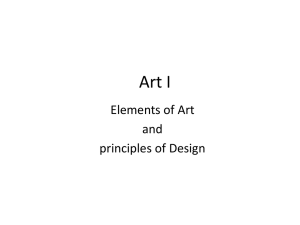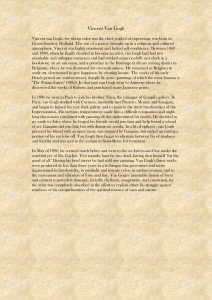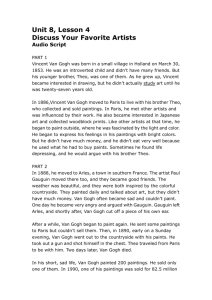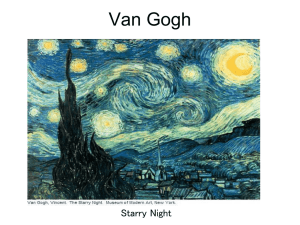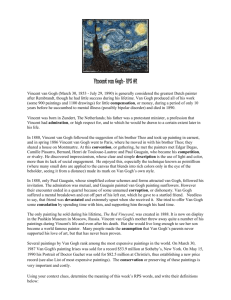Vincent Background
advertisement
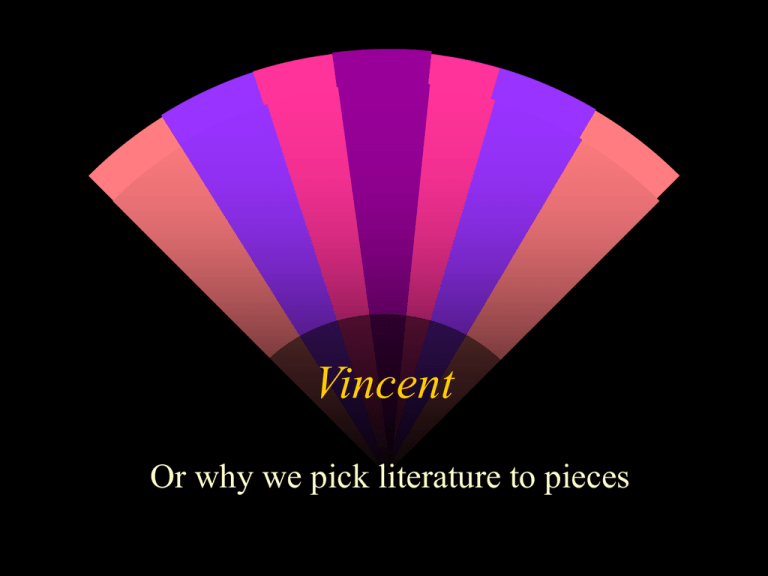
Vincent Or why we pick literature to pieces All images found at http://www.vangoghmuseum.co m/bisrd/top-1-2.html Failures Most casual art lovers see Van Gogh as a troubled, but successful artist. This is far from the actual truth of his turbulent life, which was fraught with failure in every occupational pursuit he attempted including painting, and was marked by intermittent episodes of depression, violence and acting out behaviors. Self-portrait Theo Van Gogh Thanks to the preservation of 1000's of letters Van Gogh had written to friends and family, especially to his brother Theo, we have a nearly complete understanding of his feelings, experiences, and views on every aspect of his life. Career Van Gogh’s career in art, 10 years, is one of the briefest in art history. Although 1700 of his works survived, he sold only 1 painting during his lifetime. • Sold for $80, four months before his death The Red Vineyard Childhood A look into his childhood will give us an understanding of Van Gogh's creative expression, as well as an understanding of the origins of Expressionism. 13 Years Old Childhood Charming, but stubborn and hot-tempered Sent away to boarding school at the age of 12 Left school at 16 Attempted to become a teacher and a preacher, worked in a bookstore, and sold art Began painting after 9 month withdrawal Childhood 18 years old Vincent's sister, Elizabeth Van Gogh, described his demeanor as a child. He was "intensely serious and uncommunicative, and walked around clumsily and in a daze, with his head hung low." She continued by saying, "Not only were his little sisters and brothers (he was the oldest of 8) like strangers to him, but he was a stranger to himself." Birth date Vincent van Gogh was born in Groot Zundert, The Netherlands on 30 March 1853. Van Gogh's birth came one year to the day after his mother gave birth to a first, stillborn child-also named Vincent. There has been much speculation about Vincent van Gogh suffering later psychological trauma as a result of being a "replacement child" and having a deceased brother with the same name and same birth date. This theory remains unsubstantiated, however, and there is no actual historical evidence to support it. Vincent’s Parents Van Gogh was the son of Theodorus van Gogh (182285), a pastor of the Dutch Reformed Church, and Anna Cornelia Carbentus (18191907). Van Gogh cuts off own ear! Van Gogh had a violent argument with fellow painter and housemate Gauguin He gave it to a local prostitute telling her, “Keep this object as a treasure.” Starry Night June, 1889 Starry Night was painted while Vincent was in the asylum at Saint-Rémy and his behaviour was very erratic at the time, due to the severity of his attacks. Most famous painting Portrait Toulouse-Latrec was influenced by Van Gogh’s power and intensity and his use of blue and gray colors. The Harvest June 1888 Tranquil painting emphasizing lush green and yellow fields offset by violet shadows on the sides of wagons, houses and hillsides. Landscape with Snow February, 1888 Continues Van Gogh’s love of the landscape and use of Expressionism On the Threshold of Eternity April-May, 1890 Saint-Rémy Hospital Reflects Vincent’s own condition - his experience of loneliness that lead him to complete despair Sunflowers August, 1888 Painted a series of these flowers to decorate his hospital room Notice his signature on the vase - just “Vincent” The Plains Near Auvers July, 1890 Emphasizes extreme detail, with tall grass in the foreground created by long slashes of paint Shows Van Gogh’s mastery of the landscape Last Self-portrait September, 1889 This portrait shows Vincent as he saw himself • a tortured soul, battering desperately against the terrors which surrounded him The Sower June, 1888 First work in a series showing the connection between the peasant and the cycle of life Head of a Peasant March, 1885 Van Gogh attempted to show the brutal life of the peasant Van Gogh identified with the poor and unrecognized levels of society Portrait of Patience Escalier August, 1888 Peasant farmer Depicts the sturdy qualities associated with the peasant’s life Cafe Terrace at Night September, 1888 “It amuses me enormously to paint the night right on the spot. They used to draw and paint the picture in the daytime after the rough sketch. But I find satisfaction in painting things The Night Cafe September, 1888 “I have tried to express the terrible passions of humanity by means of red and green.” “I have tried to express the idea that the cafe is a place where one can ruin oneself, go mad or commit a crime.” Corridor of Saint-Paul Asylum October, 1889 Hospital he stayed in after he cut off his ear No exact diagnosis of Vincent’s ailment was made Contemporary doctors believed he was epileptic or manicdepressive Wheat Field with Crows July, 1890 One of his last 3 paintings On Sunday, July 27, 1890, Vincent killed himself Psychologists believe this painting was a signal Portrait of Doctor Gachet June, 1890 One of Vincent’s few friends Vincent said of Dr. Gachet, “He certainly appears as ill and confused as I am.” Sold in 1990 for $82.5 million The Potato Eaters April, 1885 Attempt to depict harsh living conditions of the peasants Painted early in his career he uses the Dutch style The Drinkers February, 1890 Depicts the four ages of man drinking around a table Caricature of men drinking themselves to death Roses and Beetle April-May, 1890 Van Gogh often chose still life subject matter to decorate his hospital rooms during his several stays for mental breakdowns Bedroom at Arles Early September, 1889 “Color is everything; giving by its simplification a grander style to things, is to be suggestive here of rest and sleep in general Reflects yearning for companionship Paul Gauguin’s Armchair December 1888 Ornately carved, with aggressive arms and legs Depicts a restless personality bathed in artificial light Vincent’s Chair with Pipe December, 1888 Simple workmanship and rough unlit with tobacco pouch speak of the artist’s desolation Another self-portrait “He was an honest man and a great artist. He had only two aims, mankind and art. Art he loved above everything, and it will make him live.” -Dr. Gachet (At Van Gogh’s funeral)
